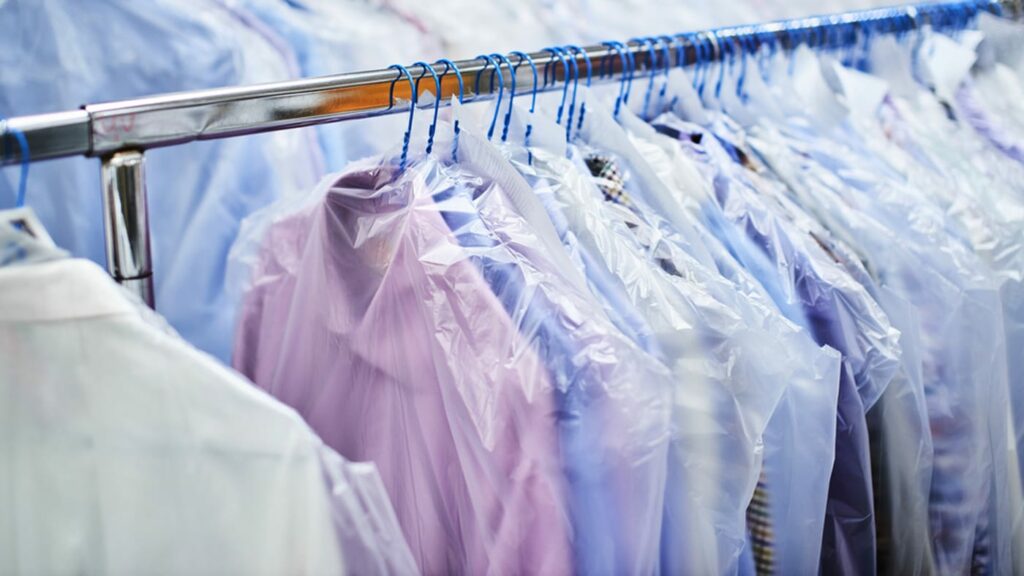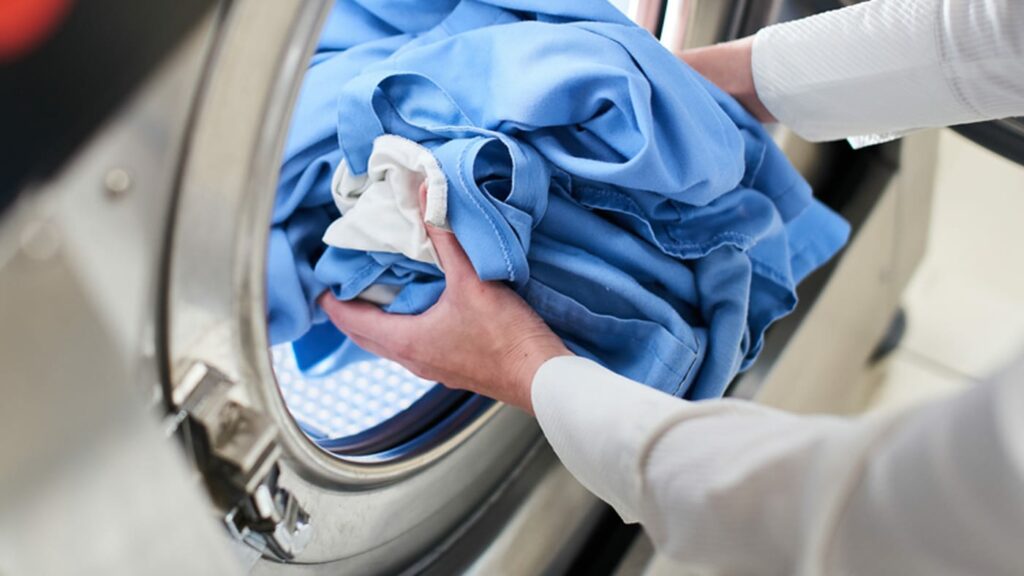
Deciding between dry cleaning and machine washing can be difficult when it comes to our valuable items. Did you know improper washing methods can severely harm certain fabrics? This blog post explains the essential distinctions between the two cleaning processes, allowing you to decide based on fabric type, stain, and durability factors.
Hold on tight because we’re going deep into the world of laundry; your clothes will thank you!
The main differences between Washing and Dry Cleaning
The offered material highlights the primary distinctions between washing and dry cleaning, focusing on four essential points: solvents used, drying procedure, overall process, and stain removal methods.
Let us go through each topic to ensure correctness and clarity.
Solvents Used:
- Dry cleaning generally employs chemical solvents for grease and oil stain removal without causing fabric shrinkage or fading. But, we use a silicon base solvent which is less harsh on the clothes and the environment while still offering high-powered cleaning.
Washing uses water and detergent to clean, although water is less effective at removing oil-based stains.
- Washing uses water and detergent to clean, although water is less effective at removing oil-based stains.
Drying Method:
- Dry cleaning employs a “tumbling” method in which clothes are moved to allow solvents to evaporate, preventing wrinkles.
- Machine washing consists of a water-based cleaning cycle followed by spinning at high speeds to extract water, with different textiles potentially requiring varying heat levels during air-drying or heat-drying.
Process:
- Dry cleaning is a waterless method in which clothing is saturated with silicon solvent, XIAMETER PMX-0245. It is a liquid silicone-based solvent made from sand. It fights stains without bleeding colors or weakening fabric integrity. It is chemically inert and has a low surface tension that allows it to disperse through a garment easily to remove built-up dirt and oil. The main ingredients are much less harsh than petroleum-based solvents and can be found in other products such as Anti Aging Creams, Hair Care, Cosmetics, and Makeup removers.
- Machine washing employs detergents and water, with a concentration on stain removal via agitation and temperature settings tailored to the fabric type.
Stain Removal:
- Dry cleaning is more effective for stubborn stains such as ink or lipstick since it uses chemical solvents instead of water.
- The agitation and water in the washing machine make it suited for common stains such as dirt or food spills.
Pros and Cons of Washing Vs Dry Cleaning
Washing clothes at home or hiring professional cleaning services might be simple and economical, but it is not always appropriate for delicate materials or difficult stains. On the other hand, while dry cleaning is a gentle and effective stain removal method, it can be costly and potentially damaging due to chemical solvents.
Consider fabric type, stain severity, and durability when deciding which treatment is best for your items.
Benefits of Washing:

Washing your clothes with a washing machine or in a commercial laundromat has various advantages.
- First and foremost, it successfully removes dirt, stains, and odors, leaving your clothes clean and fresh. Furthermore, machine washing is a practical alternative because you can simply toss your items into the washer and let the machine do the cleaning.
- It also saves time over dry cleaning because you do not have to wait for the things to be properly laundered. Furthermore, washing clothing at home with water-based detergents is typically thought to be safer and less damaging than dry cleaning, which uses toxic solvents.
Overall, machine washing is an efficient and cost-effective approach to keep your everyday apparel clean and well-maintained with minimal effort or expenditure.
Drawbacks of Washing:
Washing your clothes with a washing machine can have some drawbacks.
- One problem is that certain textiles, particularly delicate ones such as silk or wool, can be harmed in the process.
- The machine’s agitation and tumbling movement can cause sensitive materials to shrink, strain, or even tear.
- Another disadvantage is that some stains may not be entirely removed with conventional washing methods. Tough stains, such as oil or ink, may necessitate more specialized procedures to be effectively removed.
- Furthermore, excessive machine washing over time can cause colors to fade and clothing to lose shape and texture.
Benefits of Dry Cleaning:
Dry cleaning has many advantages over typical machine washing.
- For starters, it is quite good at eliminating tough stains that traditional laundry procedures may struggle with. The use of specialized solvents and chemical solutions in the dry cleaning process allows for complete stain removal while preserving delicate textiles or clothing.
- Furthermore, dry cleaning removes the possibility of shrinking or discoloring certain types of clothes, making it ideal for preserving the quality and appearance of your favorite items.
Drawbacks of Dry Cleaning:
Before you send your favorite clothing to be dry cleaned, understand the disadvantages of this cleaning procedure.
- Firstly, dry cleaning might be more expensive than machine washing. The method necessitates the use of specialized equipment and solvents, both of which are costly.
- Furthermore, some chemicals used in conventional dry cleaning processes can be hazardous to both the environment and human health.
- Finally, some fragile materials may not withstand the severe treatment of dry cleaning chemicals and methods, resulting in significant damage or discoloration.
Determining which one to choose?
When determining how to clean your items, consider the fabric type, the nature of the stains, and the garment’s longevity. These variables will help you choose between washing and dry cleaning.
Fabric Considerations
Before deciding between washing and dry cleaning, evaluate the fabric of your items. Fabrics have different care requirements. Understanding these factors can help you choose the best cleaning approach.
Delicate materials, such as silk, wool, or lace, frequently require dry cleaning to avoid damage from machine washing. In contrast, stronger materials such as cotton or polyester may normally be machine-cleaned without difficulty. By considering the fabric’s properties and special care instructions, you can ensure that your garments are cleaned successfully while retaining their quality and durability.
Stain Type
The type of stain might have a big impact on the cleaning procedure you use. Certain stains are better suited to machine washing or dry cleaning. Oil-based stains, such as grease or motor oil, may be more successfully cleaned with dry cleaning due to the use of chemical solvents. Water-based stains, such as coffee or juice, may be better suited to regular machine washing with soap and water. Understanding the nature of the stain can help you determine whether to wash or dry clean your clothes for the best stain removal outcomes.
Durability
Machine washing can be harsh on some materials, diminishing their longevity over time. The washing machine’s agitation and tumbling can cause wear and tear, particularly on delicate materials. Dry cleaning, on the other hand, is a gentler solution that can help your items last longer. Dry washing protects clothes from harsh mechanical action by utilizing chemical solvents rather than water. This makes it ideal for fragile or heavily adorned objects that would not resist machine cleaning. When it comes to durability, choosing the correct cleaning procedure for your specific materials and garments is critical to ensuring they last longer.
Final Words
The selection between washing and dry cleaning has a direct impact on the longevity and appearance of your apparel. Understanding the fundamental differences between various cleaning procedures is critical for making an informed decision. Machine washing is a convenient, cost-effective, and generally safe way to clean common clothes, effectively eliminating dirt, stains, and odors. However, it may not be suited for delicate textiles or difficult stains, and repeated machine washing can cause fabric damage over time.
Dry cleaning, on the other hand, is effective at removing stains while being gentle on delicate materials, reducing shrinkage and discoloration. However, it can be costly and environmentally harmful, and it may not be required for all garments. Consider fabric kind, stain nature, and garment durability while making your pick. This ensures that your clothing is well-cared for and retains its quality and beauty for many years. So, whether you like the convenience of machine washing or the effectiveness of dry cleaning, your clothes will appreciate the care you take.



